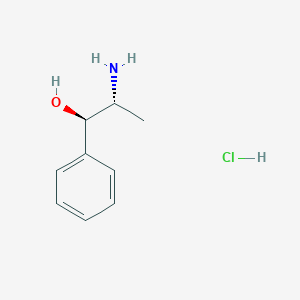

1. Dexatrim
2. Hydrochloride, Phenylpropanolamine
3. Norephedrine
4. Phenylpropanolamine
5. Phenylpropanolamine Hydrochloride
6. Prolamine
7. Propagest
8. Triaminic Dm
1. 53643-20-2
2. Phenylpropanolamine Hydrochloride
3. 154-41-6
4. Norpseudoephedrinhydrochlorid
5. Hms1569a09
6. Akos025401421
7. Ac-15986
| Molecular Weight | 187.66 g/mol |
|---|---|
| Molecular Formula | C9H14ClNO |
| Hydrogen Bond Donor Count | 3 |
| Hydrogen Bond Acceptor Count | 2 |
| Rotatable Bond Count | 2 |
| Exact Mass | 187.0763918 g/mol |
| Monoisotopic Mass | 187.0763918 g/mol |
| Topological Polar Surface Area | 46.2 Ų |
| Heavy Atom Count | 12 |
| Formal Charge | 0 |
| Complexity | 110 |
| Isotope Atom Count | 0 |
| Defined Atom Stereocenter Count | 2 |
| Undefined Atom Stereocenter Count | 0 |
| Defined Bond Stereocenter Count | 0 |
| Undefined Bond Stereocenter Count | 0 |
| Covalently Bonded Unit Count | 2 |
Adrenergic alpha-Agonists
Drugs that selectively bind to and activate alpha adrenergic receptors. (See all compounds classified as Adrenergic alpha-Agonists.)
Appetite Depressants
Agents that are used to suppress appetite. (See all compounds classified as Appetite Depressants.)
Nasal Decongestants
Drugs designed to treat inflammation of the nasal passages, generally the result of an infection (more often than not the common cold) or an allergy related condition, e.g., hay fever. The inflammation involves swelling of the mucous membrane that lines the nasal passages and results in inordinate mucus production. The primary class of nasal decongestants are vasoconstrictor agents. (From PharmAssist, The Family Guide to Health and Medicine, 1993) (See all compounds classified as Nasal Decongestants.)
Sympathomimetics
Drugs that mimic the effects of stimulating postganglionic adrenergic sympathetic nerves. Included here are drugs that directly stimulate adrenergic receptors and drugs that act indirectly by provoking the release of adrenergic transmitters. (See all compounds classified as Sympathomimetics.)

LOOKING FOR A SUPPLIER?